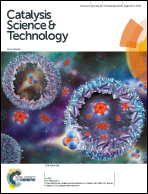Degradation of acetaminophen in aqueous solution under visible light irradiation by Bi-modified titanate nanomaterials: morphology effect, kinetics and mechanism†
Abstract
Three morphologies of Bi-modified titanate nanomaterials (Bi-TNM) were prepared using the hydrothermal method and controlled parameters to degrade acetaminophen (ACT). ACT is a high-consumption drug that exists widely in natural waters and wastewaters. The prepared samples were characterized using X-ray diffraction (XRD), scanning electron microscopy (SEM), UV-visible diffuse reflectance spectroscopy (UV-vis DRS), Fourier transform infrared spectroscopy (FT-IR), and zeta potential analyzers. The morphological effect of Bi-TNM on the visible light-driven catalytic degradation of aqueous ACT was carefully investigated using bulk, flake, and ribbon-shaped titanate catalysts. The photocatalytic activity of the prepared catalysts was evaluated based on the effect of the catalyst morphology, the initial concentration of ACT, the catalyst dosage, and the solution pH. The optimal photocatalytic performance, kinetics, and mechanism of the Bi-TNM for the degradation of ACT were achieved, respectively. The results show that the Bi-TNM photocatalyst not only enhanced the visible light adsorption, but also improved the efficiency of the photoinduced charge transfer with a high efficiency for the degradation of ACT. The photocatalytic activity of the Bi-TNM nanoribbons was significantly improved under visible light irradiation. The photocatalytic activity for the degradation of ACT was in the order of titanate nanoribbons (Bi-TNR) > titanate nano-bulks (Bi-TNB) > titanate nanosheets (Bi-TNS). The morphology of nanoribbon has a good photocatalytic activity for the degradation of ACT. Furthermore, no inactivation occurred during the three catalytic reactions and Bi-TNR exhibited an excellent photocatalytic stability. Kinetic studies on the photocatalytic degradation of ACT under visible light suggest that the degradation followed pseudo-first-order kinetics. The mechanism study showed that the hole in Bi-TNR was mainly involved in the photodegradation of ACT. The present study, using Bi-TNM, provides a better photocatalytic degradation route in comparison with pristine titanate for wastewater treatment contaminated with ACT and other persistent organic pollutants.



 Please wait while we load your content...
Please wait while we load your content...